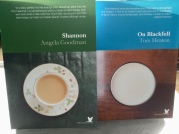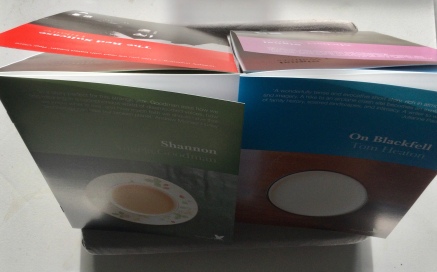Jarrings in the Night
SHANNON by Angela Goodman
SIGNAL by Michael Walters
ON BLACKFELL by Tom Heaton
THE RED SUITCASE by Hilaire
My previous reviews of NIGHTJAR PRESS: https://dflewisreviews.wordpress.com/tag/nightjar-press/
When I read these publications, my thoughts will appear in the comment stream below…



SHANNON by Angela Goodman
“Then Maurice thought of Ma, in her dark green coat and hat, struggling to find her way across the astral world among the millions who’d died of the flu.”
And, after that earlier pandemic, Maurice flew, indeed! This story that features the colour green, as well as being in a publication clothed with green. I even see Shannon, or especially such a place, as green. Ironic, then, that Maurice becomes involved at the start of the unGREEN flying of aircraft commercially between the two wars, and an even more ironic contrast with the unSEEN flying of spirits in the astral world that mediums purveyed to the gullible in those days. We follow Maurice from childhood with his crystal set and its cat’s whisker sensitive to the otherwise invisible jarrings of the night. (I even remember these crystal sets in the 1950s!) — And his being taken to spiritualist events where he hoped that he’d talk to his Ma and Pa. Or, rather, was he relieved that his parents had ‘crossed over’ and were no longer marooned earthbound? An un-earthbound state he himself managed — alongside a romantic attachment to a deaf and dumb girl — as the story unfolds, amid the cacophony of inferred spirits, toward a strikingly ingenious ending, an ending with a disarmingly infused obliquity, an ending, too, that you will never predict.
“They were connected. They both felt it.”
Two of my Welsh great-grandparents were deaf and dumb, and died from the Spanish flu pandemic.
SIGNAL by Michael Walters
“Oh God, last night’s dream. There had been a river, and she was on the bank, looking out at her sister, who was in the violently rushing water,…”
And a signature signal as of a fish leaping from those waters? There seem to be many photos of David Bowie fishing. The admirable, endlessly interpretable story of Kate, as she survives through our pre-covid urban world of flat shares and pasta comas, beyond her older sister’s death. Watching those in the windows of a residential block, a block that survives beyond Grenfell, although another block close by is demolished. Does Kate follow some destined path as preset by her sister, finding the otherwise inscrutable menfolk that once beset her? Or does she actually become her, having been thrown back into that river of time before our era of expiring. Mouth watering, but for what?
Infinity on its side. And I have not yet even factored in ‘Cabaret’ to this scenario.
A dead body like a fish in pink water and a story that ends with a fish, too.
Not forgetting its reference to a lemniscate (lemniskate)!
Thank you, Des. A lovely review. x
ON BLACKFELL by Tom Heaton
“Becoming one with the fell.”
“‘The metaphorical plane crash,’ she said.”
A perfect inadvertent accompaniment to the now viewable metaphor of plane crash above in the Goodman. Meanwhile, this is also, for me, the archetype story from the old ‘Stand Magazine’ or ‘London Magazine’ or much literary fiction these days — which statement contains a huge compliment to its evocatively fell Yorkshire Dales landscape and to the conveyed emotions of its narrator’s brotherly bereavement and to descriptions of his elderly father’s residues of a challenging hike into the fells to see fallen residues from the War of yore when Lancaster bombers flew (still do?) and of the newly suspended to-be-marital balance between a personal straining apart and paradoxically concurrent skin merge (metaphorised by the narrator’s polymer job in Paris), a balance between the narrator and his fiancée. Ironically, I myself once had stories published in Stand Magazine and in an Alan Ross London Magazine book, both in and around 1990, stories that I then felt were far from typical of those they usually published. The once ungluing of gestalt, but here panning out in a new merge of literary atoms today, there being so much more in this fiction’s crucible of Heaton that I cannot cover here. The work eventually and uniquely submits to nothing else. Archetypes have to have their source somewhere, after all, arguably in newly grafted Metaphors and Molecules, some of these inevitably, like old age, “yawing into the ground”, but others soaring beyond my own Midsommar’s leap. (Apologies for perhaps personalising this review too much.)
“The old man stared, perplexed, made tiny trigger movements as if about to speak or act, like a spectator in some baffling dream.”
My previous review of this author: https://dflewisreviews.wordpress.com/2020/09/16/strange-tales-tartarus-press-at-30/#comment-20042
THE RED SUITCASE by Hilaire
“He counted the waves as they broke on the shore, finally drifting off into the nineties.”
Or the nines? Meanwhile, this story — and I mean this as an enormous item of praise — reminds me of being within a William Trevor story, with ginger nuts, a tea cosy, and reading yesterday’s newspaper today — William Trevor, the complete canon (!) of whose stories I recently real-time reviewed, as linked from here. But, here, though, we have the unique atmosphere of Hilaire’s One End Street, near the sea, in a community with a genius loci of gossips, and a low grade guest house that requires Dougie’s mother to put up a campbed in the sitting room so as to house any guest in her own bedroom. And B arrives, unusually, for guests, off-season, with a red suitcase, and although we are given her full forename, she is ever afterward referred to as B, as if truncated even further than the name of an author who by-lines herself only by a forename? Those forenames that used to be called Christian. We gradually gather the character of B as well as of Dougie, and the unspoken, never-ignited relationship between them. The cassette player’s hiss and its quavering music, the dreams B might read within him, and his signalman’s hat he leaves outside her room as an unspoken loan to ward off the rainy grey days by the cold sea. Business as usual, not constipated at all, he tells his mother… A signalman with a signal upon Goodman’s cat’s whisker of that earlier crystal set above, and upon another jarring in the night, the story above entitled ‘Signal’. A dead seal, not a fish. Or was the signal a reminder of his earlier job, where red indicated danger? Two-way slippers on a single track of sleepers? With only one end.
end